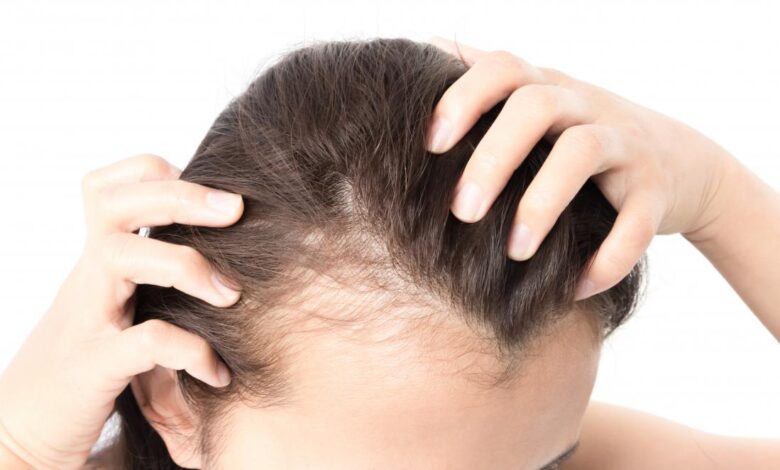
Hair loss is a common concern for many individuals, both men and women, and it can occur for various reasons. While it’s natural to shed some hair daily, excessive hair loss can be distressing and may indicate an underlying health issue. Understanding what constitutes normal hair loss and when it’s time to seek professional advice is essential for maintaining scalp health and overall well-being.
Normal Hair Growth Cycle
Before delving into what’s considered normal hair loss, it’s crucial to comprehend the hair growth cycle. Hair grows in a cycle consisting of three phases:
1. Anagen phase
This is the active growth phase, during which hair follicles grow and divide rapidly. The length of the anagen phase determines the length of the hair.
2. Catagen phase
In this transitional phase, hair growth stops, and the outer root sheath shrinks, detaching from the dermal papilla. This phase is relatively short, lasting only a few weeks.
3. Telogen phase
Also known as the resting phase, hair remains in the follicle but is not actively growing. Eventually, the old hair is shed, making room for new hair growth.
After the telogen phase, the cycle repeats, and a new hair begins to grow in the same follicle. It’s normal for individuals to shed anywhere from 50 to 100 hairs per day as part of this natural cycle.
Factors Affecting Hair Loss
Several factors can influence the rate of hair loss and the overall health of your scalp. These include:
1. Genetics
Family history plays a significant role in determining hair loss patterns. Androgenetic alopecia, commonly known as male-pattern or female-pattern baldness, is often hereditary and can lead to gradual hair thinning over time.
2. Age
As individuals age, the rate of hair growth slows down, and hair follicles may shrink, leading to thinner and more delicate hair strands.
3. Hormonal Changes
Fluctuations in hormone levels, such as during pregnancy, childbirth, menopause, or thyroid imbalances, can contribute to temporary hair loss.
4. Stress
Emotional or physical stress can disrupt the hair growth cycle, leading to increased shedding. This type of hair loss, known as telogen effluvium, is usually temporary and resolves once the stressors are alleviated.
5. Nutritional Deficiencies
Inadequate intake of essential nutrients like iron, zinc, biotin, and vitamins A, C, D, and E can impact hair health and contribute to hair loss.
6. Medical Conditions
Certain medical conditions, such as autoimmune diseases, alopecia areata, and scalp infections, can cause hair loss. Treating the underlying condition often helps restore hair growth.
When to Be Concerned
While shedding up to 100 hairs per day is considered normal, certain signs indicate that you may be experiencing excessive hair loss and should consult a healthcare professional:
1. Noticeable Thinning
If you observe a significant decrease in hair density or widening of your hair part, it may indicate excessive hair loss.
2. Sudden Hair Loss
Abrupt hair shedding, especially if it occurs in clumps or patches, may be a sign of an underlying health issue and requires prompt evaluation.
3. Scalp Conditions
Persistent itching, redness, flaking, or tenderness of the scalp could indicate a scalp infection or other dermatological condition requiring medical attention.
4. Hair Loss with Other Symptoms
If hair loss is accompanied by other symptoms like fatigue, unexplained weight loss, or changes in menstrual cycles, it may indicate an underlying medical condition that needs to be addressed.
Seeking Professional Help
If you’re concerned about hair loss beyond what’s considered normal, it’s advisable to seek guidance from a healthcare provider or dermatologist. They can evaluate your scalp health, review your medical history, and recommend appropriate diagnostic tests, such as blood tests or a scalp biopsy, if necessary. Treatment options may include topical medications, oral supplements, lifestyle modifications, or procedures like platelet-rich plasma (PRP) therapy or hair transplantation, depending on the underlying cause and severity of hair loss.
Maintaining Scalp Health
In addition to seeking professional advice, adopting healthy hair care practices can help promote scalp health and minimize hair loss:
1. Gentle Handling
Avoid harsh hair treatments, excessive heat styling, and tight hairstyles that can cause physical damage to the hair shaft and follicles.
2. Balanced Diet
Consume a nutritious diet rich in vitamins, minerals, and protein to support healthy hair growth.
3. Stress Management
Practice stress-reduction techniques such as meditation, yoga, or deep breathing exercises to mitigate the impact of stress on hair health.
4. Regular Exercise
Engage in regular physical activity to improve blood circulation to the scalp and promote optimal hair growth.
5. Scalp Care
Use gentle, sulfate-free shampoos and conditioners suitable for your hair type, and avoid overwashing or scrubbing the scalp vigorously.
For More Updates Follow: AroundUsInfo.com
While some degree of hair loss is a normal part of the hair growth cycle, excessive or sudden hair shedding may indicate an underlying health issue that requires attention. Understanding the factors influencing hair loss and recognizing when to seek professional help is essential for maintaining scalp health and preserving hair density. By adopting healthy lifestyle habits and seeking appropriate medical care, you can promote optimal hair growth and enhance your overall well-being.



